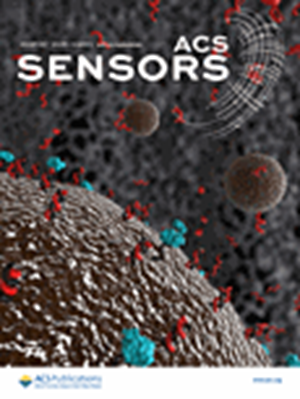利用等离子体核-卫星纳米结构实时跟踪铁死亡过程中细胞内pH动态
IF 8.2
1区 化学
Q1 CHEMISTRY, ANALYTICAL
引用次数: 0
摘要
铁凋亡是一种铁依赖性的细胞死亡过程,其特征是溶酶体膜渗透和pH失调。在这里,我们报道了一种基于i基序介导的金核-卫星纳米结构(Au CSNSs)的dna编程等离子体纳米探针,用于铁死亡期间细胞内pH动力学的单粒子分辨率测绘。i-motif DNA连接子经历了ph依赖的构象切换,动态调节了45 nm金核纳米粒子(Au core NPs)和15 nm金卫星纳米粒子(Au satellite NPs)之间的粒子间隙。该结构在pH值5.6-6.8范围内实现了较大的局部表面等离子体共振(LSPR)位移,实现了可逆的线性pH传感(R2 = 0.97),具有优异的光稳定性。在外源铁诱导的铁下垂过程中,Au CSNSs表现出与溶酶体H+渗漏相对应的快速光谱偏移,这一点通过吖啶橙染色得到证实。值得注意的是,通过雷帕霉素预处理激活线粒体自噬使细胞对低剂量铁(1 μM)敏感,触发更早、更明显的pH变化。这项工作为研究铁下垂中ph依赖性信号建立了一个新的平台,对理解线粒体-溶酶体串扰和开发靶向癌症治疗具有重要意义。本文章由计算机程序翻译,如有差异,请以英文原文为准。

Real-Time Single-Particle Tracking of Intracellular pH Dynamics during Ferroptosis Using Plasmonic Core–Satellite Nanostructures
Ferroptosis, an iron-dependent regulated cell death process, is characterized by lysosomal membrane permeabilization and pH dysregulation. Here, we report a DNA-programmed plasmonic nanoprobe based on i-motif-mediated gold core–satellite nanostructures (Au CSNSs) for single-particle resolution mapping of intracellular pH dynamics during ferroptosis. The i-motif DNA linker undergoes pH-dependent conformational switching, dynamically tuning the interparticle gap between 45 nm gold core nanoparticles (Au core NPs) and 15 nm gold satellite nanoparticles (Au satellite NPs). This architecture achieves a large localized surface plasmon resonance (LSPR) shift in the pH range of 5.6–6.8, enabling reversible and linear pH sensing (R2 = 0.97) with excellent photostability. During ferroptosis induced by exogenous iron, Au CSNSs displayed rapid spectral shifts corresponding to lysosomal H+ leakage, corroborated by acridine orange staining. Notably, mitophagy activation via rapamycin pretreatment sensitized cells to low-dose iron (1 μM), triggering earlier and more pronounced pH changes. This work establishes a novel platform for investigating pH-dependent signaling in ferroptosis, with implications for understanding mitochondria–lysosome crosstalk and developing targeted cancer therapies.
求助全文
通过发布文献求助,成功后即可免费获取论文全文。
去求助
来源期刊

ACS Sensors
Chemical Engineering-Bioengineering
CiteScore
14.50
自引率
3.40%
发文量
372
期刊介绍:
ACS Sensors is a peer-reviewed research journal that focuses on the dissemination of new and original knowledge in the field of sensor science, particularly those that selectively sense chemical or biological species or processes. The journal covers a broad range of topics, including but not limited to biosensors, chemical sensors, gas sensors, intracellular sensors, single molecule sensors, cell chips, and microfluidic devices. It aims to publish articles that address conceptual advances in sensing technology applicable to various types of analytes or application papers that report on the use of existing sensing concepts in new ways or for new analytes.
 求助内容:
求助内容: 应助结果提醒方式:
应助结果提醒方式:


